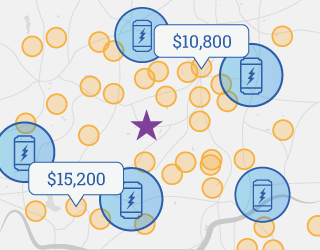Battery storage paired with solar panels is a great way to save money on electricity bills in the long term, especially with new rate plans like time-of-use becoming more prevalent. But does adding a battery mean you’ll be able to produce, store, and use electricity with solar when the grid is down? Do you even need a battery? In this article, we’ll dissect how solar and storage can make for an effective grid resiliency technique.
Solar-plus-storage can work when the grid is down
If your energy storage system has islanding capability, you’re in luck: you can keep producing solar energy and feeding it to your battery during a grid outage.
What does it mean to have islanding capability? In a nutshell, being able to island means that you can keep your property’s electrical setup energized when the grid isn’t providing power. Solar batteries with the ability to island can continue to receive electrical power from your solar panels and send that power to meet your home’s electrical needs. This effectively creates your own personal microgrid with self-contained, on-site generation (your solar panels), storage (your battery), and electricity usage.
Islanding is made possible by your solar or storage inverter. Not all solar panel systems with energy storage can automatically island – it’s important to talk to your installer to make sure they install the proper inverter equipment (and pair it with appropriate additional power electronics and storage components) that allow you to create a home energy island if you want that flexibility.
Without energy storage, solar panels (usually) stop working during a blackout
Importantly, solar panel systems almost always don’t work on their own during a blackout if installed without energy storage. The primary reason for this is safety – if your solar panel system is still producing electricity and sending it to the grid during an outage, those energized wires pose a serious safety threat to any utility workers trying to restore electric service to the grid.
There is one commonly installed solar inverter, the SMA Sunny Boy US line, that allows you to pull power from your solar panels during the day in the event of the blackout. These inverters have a built-in outlet that supplies a limited amount of power directly from your solar panels while they’re producing during daylight hours, after you physically flip the inverter’s Secure Power Supply (SPS) switch. This won’t be able to keep all of your appliances running but might be enough to keep a few critical loads active during a daytime blackout, or potentially to allow you to charge your devices during extended outages.
Why this matters for electricity users
Relying on solar-plus-storage as a resiliency tactic against grid blackouts is a very real way to keep your essential appliances up and running, given that you have the correct setup to island. As a reminder, in most cases you’ll need some form of energy storage, solar panels, and appropriate power electronics (including a solar and/or storage inverter and sometimes an automatic transfer switch, or ATS) that interface properly with your panels and battery in order to safely create an energy island on your property during blackouts.
Of course, you will only be able to produce energy when the sun is shining: during the night or on cloudy days, it will be essential to watch your consumption carefully, as fully depleting your battery may mean an extended period of time without any power. Additionally, most battery storage options send electricity through a “critical loads panel” that supplies power to only the essential appliances in your home, such as your refrigerator or any medical devices. This is important because you likely won’t be able to run all of your electronics during an extended blackout, but may be able to power most of them, depending upon your consumption habits.
Want to learn more about electricity load and how to calculate yours? Check out our article on the topic, as well as the Department of Energy’s Energy Appliance Calculator for a rough picture of your load profile.
Compare your solar options today
If you’re researching solar batteries, we at EnergySage recently released the solar Buyer’s Guide, a one-stop resource for all solar equipment currently available. Check out the Solar Batteries section to evaluate and compare different technology options. Once you’ve found the solar battery you’d like to install on your property, register for the EnergySage Marketplace and indicate which battery you’d like to be quoted.






